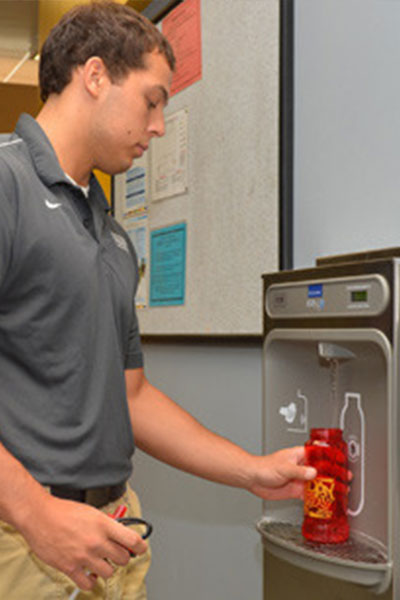Reduction

In addition to finding alternatives to landfilling waste, Iowa State University has made concerted efforts to reduce overall waste production in an effort to not rely so heavily on options for post-consumption waste diversion.
Iowa State has many campus initiatives when it comes to managing its waste production. Big Belly solar-powered trash and recycling cans, envisioned by Iowa State students, have decreased labor costs and emissions from trash pickups by having their contents digitally monitored; have the capacity to hold five times more trash than previous receptacles; and have enriched the aesthetic of Iowa State University grounds.
ISU Dining has taken a multi-faceted approach to waste reduction through their operations and the services and opportunities they offer to their customers. In 2009, ISU Dining introduced trayless dining in its newly-renovated Seasons residential dining facility. Within a few months of comparing food waste generated between a trayless facility and one still utilizing trays, there was nearly a 50% reduction. In 2010, all residential dining facilities made the switch to trayless. In addition to considering food waste, ISU Dining has also been very proactive in waste produced from disposables, specifically from coffee cups and take-away containers. Though a refill discount program had already been established for “to-go” beverages throughout campus dining facilities, ISU Dining increased marketing efforts, as well as the refill discount in 2010, and coupled this with the distribution of 11,500 reusable mugs from 2008-10. In addition, ISU Dining also introduced their “green to-go” reusable take-away container to replace disposable options, as well as increasing the use of compostable disposable containers and cutlery.
Through partnerships with Information Technology Services (ITS), a number of departments and units have reduced waste through opting for electronic options for projects, initiatives and day-to-day operations:
- Paperless options for functions including purchasing, financial transactions and communications, room scheduling, organization and event registration, venue reservation, record keeping, evaluation and exam administration, reducing paper “bubble sheets” by 61,850 during one academic year.
- Resources including the University directory, course catalog and ISU Dining menus have significantly reduced paper purchases, as well as costs and labor related to collection and recycling of diverted paper waste.
- Incorporating duplex (double-sided) printing defaults, as well as an updated print count on all ITS managed student printers that collectively reduced paper use by 33% in one semester.
- Implementation of online annual budget book via Workday Planning.
Additional ITS initiatives focused on the virtualization of servers and hardware have resulted in additional reductions of electronic waste. To date, 400 servers and 200 desktop systems have replaced traditional units. Through this initiative, not only is electronic waste reduced, energy is also conserved.
"When something is put into a trash can as waste, it isn’t just garbage to be hauled away. Within each piece of garbage is a representation of all the resources demanded, grown or mined, processed and consumed because an individual made a conscientious choice that a product was needed and necessary. Though consumption is inevitable, it can also be thoughtful, strategic and built upon sustainable practices."
-Jared Hohanshelt, Logistics and Support Services Director